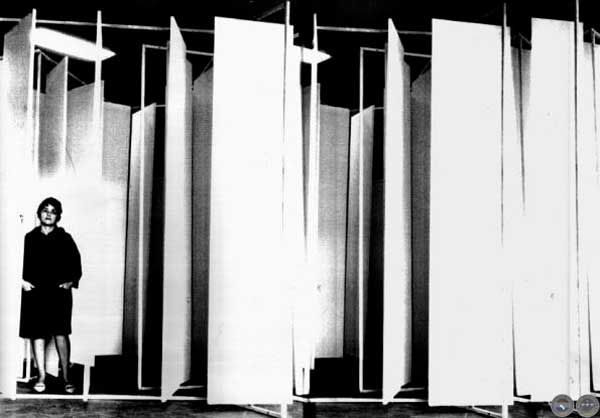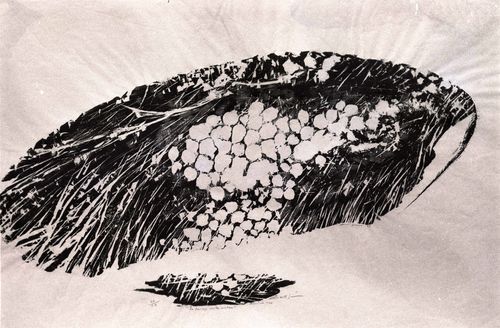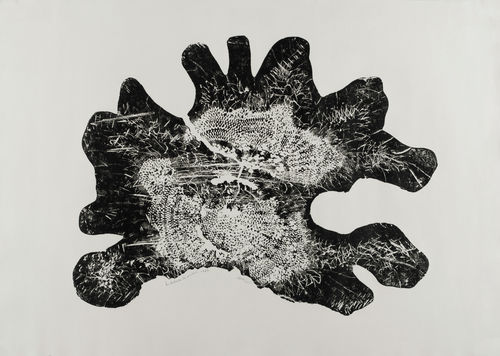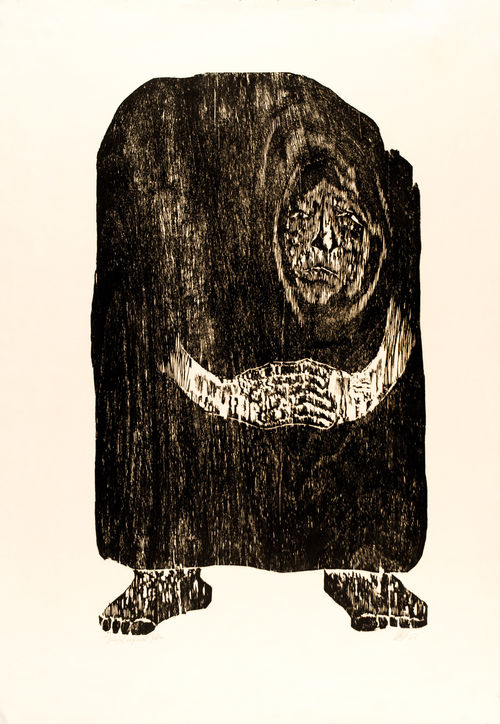A Country of Women?
Women played a central role in the history of Paraguay after the War of the Triple Alliance (1865–70).# Because the male population had been decimated on the battlefield, women had to perform the tasks of workers while also doing their part to repopulate the country.# Nevertheless, it was not until 1961 that Paraguay granted women the right to vote—the last country in Latin America to do so. Paraguayan art history is organized according to a similar scheme: while women artists are recognized as central, most of their works are not exhibited or published, and it is extraordinarily difficult to reconstruct their history.#
Nonetheless, it is possible to trace their presence in the work of, for instance, Ofelia Echagüe Vera (1904–1987), an artist trained in Montevideo and Buenos Aires whose aesthetic research was bound to the "return to order" of the period between the World Wars; in the work of Edith Jiménez (1918–2004), whose painting in modern language was exhibited at the Instituto Paraguayo-Norteamericano in 1952. Jiménez participated in the second São Paulo Bienal, in 1953, and in 1954 she joined the Arte Nuevo group, which exhibited work that evidenced an innovative spirit in the display windows along Calle Palma in Asunción. That group's aesthetic was not unified but encompassed works akin to social realism, constructivist abstraction, and stylizations of figuration. The exhibition on Calle Palma featured work by Olga Blinder (1921–2008), Ruth Fisher, Lilí del Mónico (1910–2002), and Josefina Plá (1909–1999).# Some of those artists would take part in the explorations of language, subjectivity, and corporality characteristic of art of the 1960s. Significantly, 1954 also witnessed the onset of the dictatorship of Alfredo Stroessner, who would remain in power until 1989—thirty-five years during which Paraguayan society endured death, torture, and exile.#
Edith Jiménez's woodcuts allude to the body without showing it. Printed in black and white using parts of trees as printing elements, the abstract forms suggest body parts and substances. The woodcuts Los dedos en la madera (Fingers in the wood), Los ojos en la madera (Eyes in wood), and La sangre en la madera (Blood in the wood), all from 1967, have the impact of an enormous stain rich with life—the life of trees and of the bodies to which the titles refer (figs. 1a and 1b).
The body is at center stage in the prints that Olga Blinder produced in the 1960s. In works such as Inútil espera (Useless wait; fig. 2), the female body makes reference to a semantic field that associates more universal aspects of female experience# with the specific situation of Paraguayan women—waiting for companions in exile or for political change in the country.# Other prints by Blinder make reference to the afflicted body as well. Her series of woodcuts titled Los torturados (The tortured) employs two formats: works in which the human body depicted is placed at the outer edge of the sheet and works in which the bodies are lined up—sometimes even placed on top of one another—like a geometric motif that cuts across a composition framed by two planes printed in intense blue. The composition gives a sense of the confinement, suffering, and suffocation experienced by an imprisoned body. Blinder even decomposed the body, depicting, alongside the aligned bodies, fragments, knots of bone, and bundles of flesh on a flat black plane rendered by a wooden matrix. The life that makes itself felt in the texture—the texture of nature, the texture of wood—contrasts with the confinement of the figures. Blinder explained that when the Stroessner dictatorship began to grasp the oppositional nature of her works, her passport was taken away and she could not travel to the United States for an exhibition of her work.#

Women artists were at the center of the experimental work in installation and performance that emerged in the 1960s. Laura Márquez (b. 1929), for instance, was eighteen years old when she went to Buenos Aires to study art. While there, she took part in the student movement to reform art academies and came into contact with kinetic art, the experimentation at the Instituto Torcuato Di Tella, and the art critic Jorge Romero Brest. In 1967 her Puertas inútiles (Useless doors, 1967; fig. 3) was exhibited at the 9th São Paulo Bienal, as well as in Montevideo and in Buenos Aires. Ticio Escobar describes that work as a forest of intertwining doors, a theatrical and labyrinthine space that speaks of confusion, of divergence and misunderstanding.# With so many ways in and so many ways out—none of them definitive—this labyrinth can be interpreted in terms of identity, subjectivity, and an investigation of one's own consciousness in the form of a question that has no answer.
Excerpted from Radical Women: Latin American Art, 1960–1985. Copyright © 2017 by the Armand Hammer Museum of Art and Cultural Center, Inc. Published by DelMonico Books, an imprint of Prestel. The full essay can be found in the exhibition catalogue, available here.
The War of the Triple Alliance—in which Argentina, Brazil, and Uruguay fought against Paraguay—resulted in that country losing much of its territory due to annexations by Argentina and Brazil. The most widely accepted explanation of the conflict maintains that under the administrations of Gaspar Rodríguez de Francia (1814–40) and Francisco Solano López (1862–70), Paraguay experienced intense economic growth despite its isolation (it was the first country in the region with a functioning railway system, for instance, which was inaugurated in 1861). That prosperity was seen as a threat by other countries in the region, especially Brazil.
The war resulted in a demographic catastrophe. Estimates of the country's population and losses vary widely, but according to one account, Paraguay's "prewar population of approximately 525,000 was reduced to about 221,000 in 1871, of which only about 28,000 were men" (Encyclopaedia Britannica, s.v. "War of the Triple Alliance"). The war was followed by a cholera epidemic. Smallpox, measles, and yellow fever were endemic. The 1886 census showed that there were 70 percent fewer men than women between the ages of fifteen and forty-five and that the birth rate was 17 percent lower than before the war. The demographic crisis that began in 1870 would begin to subside only after 1910. Some authors argue that the government enacted two policies to combat this state of affairs: immigration and free love (polygamy and polyandry). See Harris Gaylord Warren, Paraguay and the Triple Alliance: The Postwar Decade, 1869–1878 (Austin: Institute of Latin American Studies, University of Texas, 1978). Others assert that free love had been a part of Paraguayan history since before colonial times and that European settlers engaged in the long-standing Guaraní custom of polygamy. For that reason Paraguay came to be called "Muhammad's paradise"; chroniclers report that some of the conquerors had more than fifty wives who were forced to work long days at the loom. On these topics, and for a discussion of the modification of the concept of family as a result of the war, see Barbara Potthast-Jutkeit, "The Ass of a Mare and Other Scandals: Marriage and Extramarital Relations in Nineteenth-Century Paraguay," Journal of Family History 16, no. 3 (1991): 215–39, and ¿Paraíso de Mahoma? o ¿País de las mujeres? El rol de la familia en la sociedad paraguaya del siglo XIX (Asunción: Instituto Cultural Paraguayo-Alemán, 1996).
Although there are Wikipedia entries for very few of the artists mentioned in this text—or included in this exhibition, for that matter— there is a portal that offers access to information about them (www .portalguarani.com). There are also books such as Ticio Escobar, Una interpretación de las artes visuales en el Paraguay, vols. 1 and 2 (Asunción: Colección de las Américas, Centro Cultural Paraguayo-Norteamericano, 1982–84), and Josefina Plá, Olga Blinder, and Ticio Escobar, Arte actual en el Paraguay, 1900–1980: Antecedentes y desarrollo del proceso en las artes plásticas (Asunción: IDAP, 1983).
The other artists participating in the show were Joel Filártiga, Mariano Grotovsky, and José Laterza Parodi.
Stroessner was the first head of state to visit Augusto Pinochet after the coup in Chile. Pertinent to this context is the Plan Condor, which during the 1970s and 1980s linked the dictatorships in Argentina, Bolivia, Brazil, Chile, Paraguay, and Uruguay, and—to a lesser extent—Colombia, Ecuador, Peru, and Venezuela. The US-backed plan entailed the exchange of intelligence for persecution (imprisonment, transport, and torture) of persons it considered subversive.
Inútil espera brings to mind Faith Wilding's poem Waiting, which the artist performed as a monologue at Womanhouse in Los Angeles in 1972. The poem "condenses a woman's entire life into a monotonous, repetitive cycle of waiting for life to begin while she is serving and maintaining the lives of others." http://faithwilding.refugia.net/waiting.html.
The report of the Comisión de la Verdad y la Justicia (2008) stated that 3,470 persons were forced into exile by the regime and 17,348 left of their own volition. Fifty-seven percent went to Argentina.
In an interview Blinder explained, "All those things I told you happened in the Stroessner years: being denied a visa to go to the United States; having to withdraw my prints from an international exhibition to which we were invited. As soon as they realized that there was another way to express condemnation, they started censoring. We were, by that point, enemies, known enemies. But before they hadn't realized [what we were doing]." Olga Blinder, from an interview conducted by Ángel Mariano Jara Oviedo in 2007, quoted in his essay "Algunos aspectos de la obra de Olga Blinder," http://paraguay.sociales.uba.ar/files/2011/08/P_Jara_2011.pdf.
Escobar, Una interpretación, 2:227.








